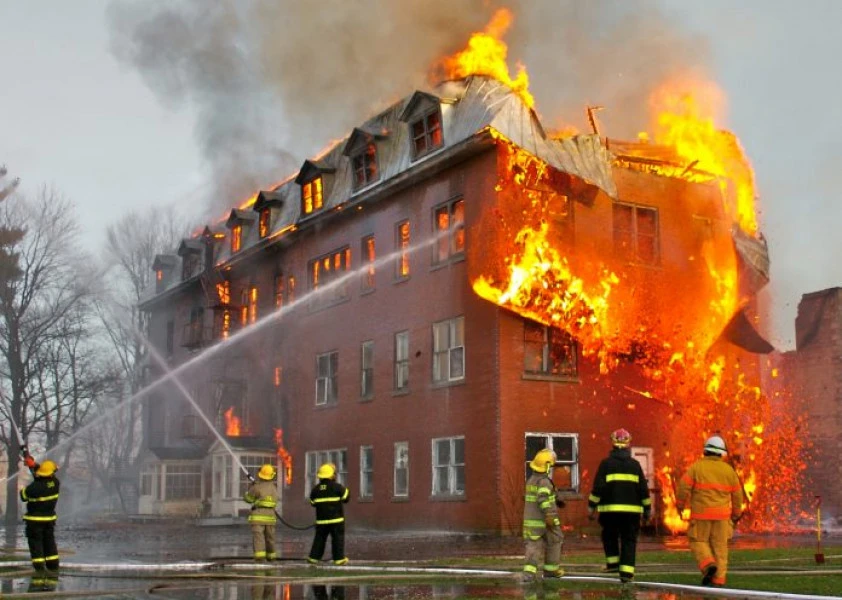Roof Maker discuss the changes in fire regulations over time, and how you can ensure your building is protected.
In 2015-16, fire and rescue services in England attended 529,000 incidents: a 7% increase compared with the previous year. In total, there were 303 fire-related fatalities, and 7,661 casualties. Fire brings devastation to buildings and lives, and the government has made regular amendments to Building Regulations over the years, most recently in 2013.
However, not everyone is taking note. Just recently, residents of an apartment block in Manchester were forced to move out after it was found that fire safety standards hadn’t been met.
The Building Regulations for fires are split into five sections, taking into account two types of buildings:
Dwelling Houses: Places where people live, including sheltered houses (excluding flats).
Buildings Other Than Dwelling Houses: Offices, hospitals, shopping centres, apartment blocks etc.
We’ll outline each section of the regulations below and discuss how to equip both dwellings and non-dwellings to ensure the building – and people inside – are safe and protected from potential fires.
B1: Warning and Escape
The regulation outlines two routes of escape: the first is horizontal, which refers to moving across a floor of a building towards a stairwell. The second method is vertical, which refers to walking down the staircase to safety.
It’s crucial that these stairs lead people directly outside without needing to pass through another section of the building; and each room must lead directly to an escape route. The only exception here is for kitchens, bathrooms, laundry and utility rooms.
You should also consider wheelchair users too: vertical circulation must be present on the landing of each stairwell, so that they can safely wait for assistance.
Perhaps the most important thing to remember is that your fire alarms are adequate and working. They must have a standby power supply and extensions on buildings must also have fire alarms.
For dwellings, smoke alarms should be fitted no further than 7.5 metres away from a bedroom door, and also be located in landings and halls. You should place one in the kitchen – especially if you have an open plan area.
Don’t forget to test your fire alarm at least once a week. If you’re in a large building such as a block of flats or offices then it’s important to run drills so that everyone knows how to exit the building safely, should a fire occur.
According to official statistics, 28% of all dwelling fires, and 33% of non-dwelling fires that occurred didn’t have a fire alarm, which could have alerted the people inside much sooner.
B2: Internal Fire Spread (Linings)
Fire is spread through flammable materials, so it’s important that you reduce the risk and rate of this happening.
You may not be aware of this, but fire is most commonly spread through walls and ceilings, as opposed to floors (furniture can play a part too).
For load-bearing walls (one which supports other elements of the building), it’s important that they’re built with steel beams so they can resist fire for 30 minutes, allowing time for people to escape. Alternatively, if you have a concrete beam, then provided it has steel reinforcement inside, that should be adequate too.
For internal walls and ceilings, materials used must be Class-1 rated in order to prevent fire from spreading. These materials usually have two layers: an intumescent first coat and a flame-resistant top coat.
If you have timber cladding then you can apply a paint-on coating to protect it to a Class-1 degree.
B3: Internal Fire Spread (Structure)
This refers to the concept of compartmentation, which breaks down the building into smaller areas, in order to restrict the spread of a fire.
For non-dwellings especially, each floor should be viewed as a compartment, which can be subdivided further if necessary. The “protected route” (the stairwell), must also be referred to as a compartment, despite being vertical.
Cavities in walls must be closed at compartment boundaries by fire-resistant material to stop the spread of fire internally.
B4: External Fire Spread
It’s not just preventing an internal fire that needs to be a priority; it’s externally too. The issue is if combustible materials such as timber or plastic cladding are found close to a boundary. These walls must therefore be fire-resistant to stop fires from spreading to nearby buildings.
One issue you need to consider are the glass in windows, as in order to prevent fire from spreading, it must be fire rated. However, you should not forget that a window represents a means of escape, so once opened, there should be adequate space for a person to climb through.
B5: Access and Facilities for the Fire Service
If a fire has occurred then obviously once you’ve called the fire services, you’ll want them to reach you as quickly as possible. However, you need to ensure the following:
Fire engines must be able to reach the building.
The equipment (eg a hose), must be able to reach the location of where the fire is inside the building.
There must be an adequate supply of water, at the right pressure, available to fight the fire.
This is usually doable in dwellings, but the second point can become more difficult for larger buildings, such as high-rises. In this case, dry risers must be vertically installed on each floor, so that firefighters can connect their equipment and deal with the fire.
Fires can be caused by a range of things, but cigarettes, cooking appliances and electrical items are the most common culprits. Understanding the reasons is one important way to help prevent fires; but you should also ensure that your building (regardless of its use) meets fire safety requirements, so that should one occur, damage is minimised and those inside can reach safety.
Original Source: Planning and Building Control Today





